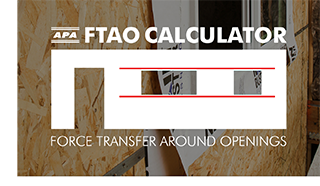Spring 2024

Highlights from this Month's e-Newsletter
- Feature—2024 Timber-Strong Design Build Competition: Small Buildings, Big Educational Opportunities
- Getting Technical—Updated Shear Wall Design Tools Available
- Inside the Circle—Meet Engineered Wood Specialist Aleeta Dene, PE
Feature
2024 Timber-Strong Design Build Competition: Small Buildings, Big Educational Opportunities

Some designed playhouses. One team created a “barndominium.” And at least one erected a tiny pub.
Those are just three entry examples from the 2024 Timber-Strong Design BuildSM competition, which took place nationwide at college campuses this spring. Since 2019, the contest has given engineering students the opportunity to gain hands-on experience with wood design and construction. It also teaches teamwork, planning and demonstrates the value of prefabrication. What began as a giant Jenga contest more than seven years ago today attracts hundreds of participating students and over a thousand spectators. This year’s competition included 464 students from 46 schools.
APA – The Engineered Wood Association, the American Wood Council and Simpson Strong-Tie partner with the American Society of Civil Engineers to carry out the competition.
This year’s winners included teams from Michigan, Indiana, Florida, Colorado, Utah, Texas, California and Puerto Rico.
Participating students were tasked with drafting and building an attractive, sustainable and durable two-story wood-frame structure. Among its requirements:
- Maximum height of 12 feet.
- Openings for at least three windows (one per wall) on the first floor.
- A windowless first-floor wall must have a door.
- The second level must have a floor opening.
- The second floor must be cantilevered 12 inches in one direction.
- The second level must have framed openings for four windows (one per wall).
Teams prepare project budgets, adhere to Occupational Safety and Health Administration safety guidelines and the model building code. Each structure is required to show a continuous load path for both gravity and wind loads. Mirroring real-world conditions, each team had to navigate the submittal, requests-for-information and change order processes.
John Wilkinson, head judge for the Eastern Great Lakes region, said the contest allowed students to collaborate and use their skills in structural calculations, building information modeling and physical construction. And it was good practice for their future careers, he added.
“This competition is a great example of how the interactions between designers and instructors in the field (go),” Wilkinson said.
Aidan Zydiak was a captain for the University of Florida's design team. Zydiak said the competition gave him the chance to learn about BIM software for the first time.
"I feel that using the software was the most applicable part of the project to my career in the future," he said. "I also enjoyed cutting the wood and building the structure. Bringing the design to physical reality was satisfying."
The competition’s time constraints were also important. Aleeta Dene, an Engineered Wood Specialist in APA’s Field Services Division, said that although teams had 90 minutes to build their structures, finishing first wasn’t necessarily a goal.
“The most successful teams take it apart and put it together multiple times” to ensure the structure was built right, she said.
This year’s first place winners included Michigan Technological University, Florida Agricultural and Mechanical University-Florida State University, LeTourneau University, Colorado School of Mines, Utah State University, and California Polytechnic State University-San Louis Obispo, in their respective symposia.
VIEW THE FULL LIST OF 2024 WINNING TEAMS ►
Getting Technical
 Updated Shear Wall Design Tools Available
Updated Shear Wall Design Tools Available
 Are you familiar with force transfer around openings (FTAO) shear walls? Designers are discovering that it offers more versatility and often requires fewer hold-downs than traditional shear walls.
Are you familiar with force transfer around openings (FTAO) shear walls? Designers are discovering that it offers more versatility and often requires fewer hold-downs than traditional shear walls.
APA now has several complimentary tools to help designers learn how to use this method:
- Design for Force Transfer Around Openings. A technical note providing rational analysis for applying FTAO to walls with asymmetric piers or multiple openings.
- APA FTAO Calculator. An Excel-based tool for professional designers that uses FTAO methodology to calculate maximum hold-down force for uplift resistance, required horizontal strap force for the tension straps above and below openings, maximum shear force to determine sheathing attachment, and maximum deflection of the wall system.
- On-Demand Webinar: Design for Force Transfer Around Openings. Explains how to use the calculator to design code-compliant FTAO shear walls. AIA and ICC credit available.
GET THESE TOOLS ►
Inside the Circle
 Meet Aleeta Dene
Meet Aleeta Dene
Aleeta is an Engineered Wood Specialist in APA's Field Services Division. She graduated with a bachelor’s degree in architectural engineering from Cal Poly-San Luis Obispo before becoming a licensed professional engineer in California. Aleeta is based in Los Angeles and provides comprehensive technical and educational support to building and design professionals across the Southwest region regarding engineered wood products. She has nine years of structural design experience throughout California and an extensive background in wood design, including single-family homes, medical and veterinary facilities, and several schools. Aleeta is an active member of SEAOC and ICC in Los Angeles.
CONTACT ►
Archived Newsletters
Winter 2023 GO ►
Fall 2023 GO ►
Summer 2023 GO ►
Spring 2023 GO ►
Fall 2022 GO ►
Spring 2022 GO ►
Winter 2022 GO ►
Autumn 2021 GO ►
Summer 2021 GO ►
Spring 2021 GO ►
Winter 2021 GO ►
Autumn 2020 GO ►
Summer 2020 GO ►
Spring 2020 GO ►